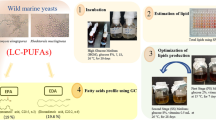The physiological roles of omega-3 fatty acids, eicosapentaenoic acid and docosahexaenoic acid have been investigated in detail and microbial strains producing these polyunsaturated fatty acids have been characterised. It has recently been suggested that docosapentaenoic acid may have an important role, especially in infant nutrition, and that its positive health effects have been overlooked. Docosapentaenoic acid (C22:5, ω-3) production by a strain of Pythium acanthicum ATCC 18660 was thus investigated. Optimum conditions for growth of P. acanthicum ATCC 18660 and docosapentaenoic acid production were: pH 6.0, temperature 20°C and incubation time, 10 days. Among different saccharides and complex nitrogen sources tested, glucose and sodium glutamate were preferred carbon and nitrogen sources, respectively. Maximum biomass content (10.4 g L−1) and docosapentaenoic acid yield (49.9 mg L−1) were obtained in 10 days. An increase in docosapentaenoic acid volumetric yields to 108–110 mg L−1 was obtained when linseed oil was used to supplement glucose or soy flour-containing medium. Batch feeding of additional glucose or linseed oil further enhanced the docosapentaenoic acid volumetric yield to 132 mg L−1 and 125 mg L−1, respectively, in 14 days. The specific production of docosapentaenoic acid in preliminary experiments ranged from 1.0–5.0 mg g−1 biomass. As conditions were optimised, docosapentaenoic acid specific production titers were generally in the range of 4.0–5.5 mg g−1 and increases in docosapentaenoic acid volumetric production could be attributed to increased biomass production. The limited improvement obtained by modifying culture conditions indicates that increasing volumetric yields of docosapentaenoic acid by modifying culture conditions appears to represent a significant barrier to commercialisation of such a process and suggests a more fundamental manipulation of metabolism and physiology is required.
Similar content being viewed by others
Author information
Authors and Affiliations
Additional information
Received 06 November 1997/ Accepted in revised form 10 January 1998
Rights and permissions
About this article
Cite this article
Singh, A., Ward, O. Docosapentaenoic acid (C22:5, ω-3) production by Pythium acanthicum . J Ind Microbiol Biotech 20, 187–191 (1998). https://doi.org/10.1038/sj.jim.2900505
Issue Date:
DOI: https://doi.org/10.1038/sj.jim.2900505




